Saint Sophie Ukrainian Orthodox Cathedral
1962 establishments in Quebec20th-century Eastern Orthodox church buildings20th-century churches in CanadaCanadian church stubsCathedrals in Montreal ... and 7 more
Church buildings with domesChurches completed in 1962Eastern Orthodox church stubsMontreal stubsRosemont–La Petite-PatrieUkrainian-Canadian culture in QuebecUkrainian Orthodox Church of Canada cathedrals

Saint Sophie Ukrainian Orthodox Cathedral (Ukrainian: Українська Православна Катедра Святої Софії) is a Ukrainian Orthodox cathedral in Montreal, Quebec, Canada. It is located on Saint-Michel Boulevard, corner De Bellechasse Street, in the borough of Rosemont–La Petite-Patrie. It was designed by architect Volodymyr Sichynsky and constructed from 1960 to 1962. Its front facade is in stone, although its exterior walls are made of brick. Its roof is made of copper. In 1988, St. Sophie was elevated to the status of "cathedral."The parish priest is the Very Reverend Father Volodymyr Kouchnir.
Excerpt from the Wikipedia article Saint Sophie Ukrainian Orthodox Cathedral (License: CC BY-SA 3.0, Authors, Images).Saint Sophie Ukrainian Orthodox Cathedral
Boulevard Saint-Michel, Montreal Rosemont–La Petite-Patrie
Geographical coordinates (GPS) Address Nearby Places Show on map
Geographical coordinates (GPS)
| Latitude | Longitude |
|---|---|
| N 45.553841666667 ° | E -73.582377777778 ° |
Address
Boulevard Saint-Michel 6000
H1Y 2H5 Montreal, Rosemont–La Petite-Patrie
Quebec, Canada
Open on Google Maps






